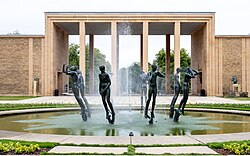
Back مجتمع كرانبروك التعليمي Arabic Cranbrook Educational Community German Cranbrook Educational Community Finnish Cranbrook Community French クランブルック教育コミュニティー Japanese Cranbrook Educational Community Swedish
Cranbrook | |
 Cranbrook Art Museum | |
| Location | 39221 Woodward Avenue Bloomfield Hills, Michigan |
|---|---|
| Coordinates | 42°34′3.4″N 83°14′36.9″W / 42.567611°N 83.243583°W |
| Built | 1926–99 |
| Architect | Eliel Saarinen |
| Architectural style | 20th Century American |
| NRHP reference No. | 73000954 |
| Significant dates | |
| Added to NRHP | March 7, 1973[1] |
| Designated NHLD | June 29, 1989[2] |
The Cranbrook Educational Community is an education, research, and public museum complex in Bloomfield Hills, Michigan. This National Historic Landmark was founded in the early 20th century by newspaper mogul George Gough Booth. It consists of Cranbrook Schools, Cranbrook Academy of Art, Cranbrook Art Museum, Cranbrook Institute of Science, and Cranbrook House and Gardens. The founders also built Christ Church Cranbrook as a focal point in order to serve the educational complex. However, the church is a separate entity under the Episcopal Diocese of Michigan.[3] The sprawling 319-acre (1,290,000 m2) campus began as a 174-acre (700,000 m2) farm, purchased in 1904. The organization takes its name from Cranbrook, England, the birthplace of the founder's father.
Cranbrook is renowned for its architecture in the Arts and Crafts and Art Deco styles. The chief architect was Eliel Saarinen while Albert Kahn was responsible for the Booth mansion. Sculptors Carl Milles and Marshall Fredericks also spent many years in residence at Cranbrook.
- ^ "National Register Information System". National Register of Historic Places. National Park Service. April 15, 2008.
- ^ "Cranbrook". National Historic Landmark summary listing. Archived from the original on July 26, 2014. Retrieved June 27, 2008.
- ^ Coir, Mark (2005). "Cranbrook: A brief history" (PDF). Cranbrook Community. Retrieved March 22, 2019.